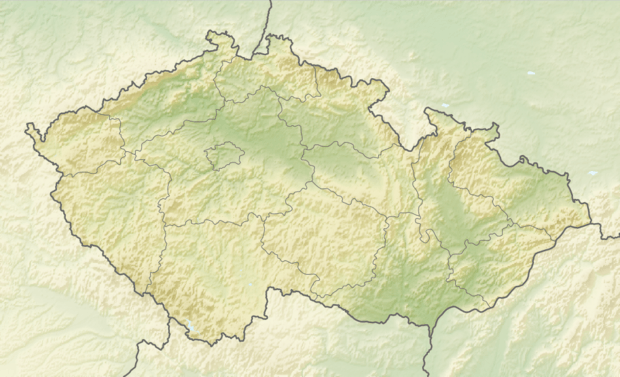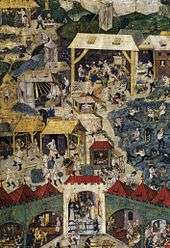Kutná Hora
Kutná Hora (Czech pronunciation: [ˈkutnaː ˈɦora] (![]()
Kutná Hora | |
|---|---|
Town | |
 Vineyard of Kutná Hora | |
 Flag  Coat of arms | |
 Kutná Hora Location in the Czech Republic | |
| Coordinates: 49°56′54″N 15°16′6″E | |
| Country | |
| Region | Central Bohemian |
| District | Kutná Hora |
| Founded | 13th century |
| Government | |
| • Mayor | Josef Viktora (ANO) |
| Area | |
| • Total | 33.05 km2 (12.76 sq mi) |
| Elevation | 254 m (833 ft) |
| Population (2020-01-01[1]) | |
| • Total | 20,653 |
| • Density | 620/km2 (1,600/sq mi) |
| Time zone | UTC+1 (CET) |
| • Summer (DST) | UTC+2 (CEST) |
| Postal code | 284 01 |
| Website | www |
| Official name | Historical Town Center with the Church of St. Barbara and the Cathedral of Our Lady at Sedlec |
| Criteria | ii, iv |
| Reference | 732 |
| Inscription | 1995 (19th session) |
History

The town began in 1142 with the settlement of Sedlec Abbey, the first Cistercian monastery in Bohemia, Sedlec Monastery, brought from the Imperial immediate Cistercian Waldsassen Abbey. By 1260, German miners began to mine for silver in the mountain region, which they named Kuttenberg, and which was part of the monastery property. The name of the mountain is said to have derived from the monks' cowls (the Kutten) or from the word mining (kutání in old Czech). Under Abbot Heidenreich, the territory greatly advanced due to the silver mines which gained importance during the economic boom of the 13th century.
The earliest traces of silver have been found dating back to the 10th century, when Bohemia already had been in the crossroads of long-distance trade for many centuries. Silver dinars have been discovered belonging to the period between 982–995 in the settlement of Malín, which is now a part of Kutná Hora.
From the 13th to 16th centuries, the town competed with Prague economically, culturally, and politically.[2] Since 1995, the town center has been a UNESCO World Heritage Site.[3]
In 1300, King Wenceslaus II of Bohemia issued the new royal mining code Ius regale montanorum (also known as Constitutiones Iuris Metallici Wenceslai II). This was a legal document that specified all administrative as well as technical terms and conditions necessary for the operation of mines.[4] The town developed with great rapidity, and at the outbreak of the Hussite Wars in 1419 was the second most important town in Bohemia, after Prague, having become the favourite residence of several Bohemian kings. It was here that, on January 18, 1409, Wenceslaus IV signed the famous Decree of Kutná Hora, by which the Czech university nation was given three votes in the elections to the faculty of Prague University as against one for the three other nations.
In 1420, Emperor Sigismund made the town the base for his unsuccessful attack on the Taborites during the Hussite Wars, leading to the Battle of Kutná Hora. Kuttenberg (Kutná Hora) was taken by Jan Žižka, and after a temporary reconciliation of the warring parties was burned by the imperial troops in 1422, to prevent its falling again into the hands of the Taborites. Žižka nonetheless took the place, and under Bohemian auspices it awoke to a new period of prosperity.
Along with the rest of Bohemia, Kuttenberg (Kutná Hora) passed to the Habsburg Monarchy of Austria in 1526. In 1546, the richest mine was severely flooded. In the insurrection of Bohemia against Ferdinand I the town lost all its privileges. Repeated visitations of the plague and the horrors of the Thirty Years' War completed its ruin. Half-hearted attempts after the peace to repair the ruined mines failed; the town became impoverished, and in 1770 was devastated by fire. The mines were abandoned at the end of the 18th century. In this town, Prague groschen were minted between 1300–1547/48.
In May 1742 during the First Silesian War, a Prussian force under Frederick the Great stopped in the town prior to the Battle of Chotusitz.[5]
Bohemia was a crownland of the Austrian Empire in 1806, and remained controlled by the Austrian monarchy after the compromise of 1867). Until 1918, Kuttenberg was the capital of the district of the same name, one of the 94 Bezirkshauptmannschaften in Bohemia.[6]
Together with the rest of Bohemia, the town became part of the newly founded Czechoslovakia after World War I and the collapse of Austria-Hungary. Kutná Hora was incorporated into the Protectorate of Bohemia and Moravia by Nazi Germany in the period 1939–1945, but was restored to Czechoslovakia after World War II. The town became part of the Czech Republic in 1993, after the dissolution of Czechoslovakia.
Architecture
The center of Kutná Hora and Sedlec Abbey with its famous ossuary are a UNESCO World Heritage Site. Among the most important buildings in the town are the Gothic, five-naved St. Barbara's Church, begun in 1388, and the Italian Court, formerly a royal residence and mint, which was built at the end of the 13th century. The Gothic Stone Haus, which since 1902 has served as a museum, contains one of the richest archives in the country. The Gothic St. James's Church, with its 86 m (282 ft) tower, is another prominent building. Sedlec is the site of the Gothic Cathedral of Our Lady and the famous Ossuary.
Main sights
- St. Barbara's Church
- Church of the Assumption of Our Lady and Saint John the Baptist
- Sedlec Ossuary
- Church of St. James
- Church of St. John Nepomuk
- Church of Ursuline Convent
- Jesuit College
- Italian Court
- Marian column
Notable people
- Jakob Jakobeus (1591–1645), Slovak writer
- Jan Erazim Vocel (1803–1871), poet, archaeologist, historian and cultural revivalist
- František Zelenka (1904–1944), architect, graphic, stage set and costume designer
Twin towns – sister cities
Kutná Hora is twinned with:[7]










Gallery
.jpg) St. Barbara's Church and Jesuit College
St. Barbara's Church and Jesuit College_16.jpg) St. Barbara street along Jesuit College
St. Barbara street along Jesuit College_11.jpg) St. Barbara's Church
St. Barbara's Church- Sedlec Ossuary
.jpg) Church of the Assumption of Our Lady and Saint John the Baptist
Church of the Assumption of Our Lady and Saint John the Baptist- Palackého Square
 St. James Church
St. James Church- Black Death memorial
See also
- Deer Park Žehušice – natural reserve with white deer, located 15 km (9 mi) to the east
- Jáchymov – another Bohemian silver mining town
References
- "Population of Municipalities – 1 January 2020". Czech Statistical Office. 2020-04-30.
- "Discover Czech". Retrieved 2007-03-07.
- "UNESCO page on Kutná Hora". Retrieved 2007-03-07.
- "Town history". Retrieved 2007-03-07.
- Berry, Jeff. "Chotusitz 1742". Obscure Battles. Retrieved 14 July 2019.
- Die postalischen Abstempelungen auf den österreichischen Postwertzeichen-Ausgaben 1867, 1883 und 1890, Wilhelm KLEIN, 1967
- "Partnerská města" (in Czech). Město Kutná Hora. Retrieved 2019-08-23.
External links
| Wikimedia Commons has media related to Kutná Hora. |
| Wikivoyage has a travel guide for Kutná Hora. |